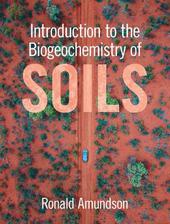
|
Introduction to the Biogeochemistry of Soils
Hardback
Main Details
| Title |
Introduction to the Biogeochemistry of Soils
|
| Authors and Contributors |
By (author) Ronald Amundson
|
| Physical Properties |
| Format:Hardback | | Pages:230 | | Dimensions(mm): Height 253,Width 194 |
|
| Category/Genre | Geology and the lithosphere
Management of land and natural resources |
|---|
| ISBN/Barcode |
9781108831260
|
| Classifications | Dewey:631.4 |
|---|
| Audience | | Tertiary Education (US: College) | | Professional & Vocational | |
|---|
| Illustrations |
Worked examples or Exercises
|
|
Publishing Details |
| Publisher |
Cambridge University Press
|
| Imprint |
Cambridge University Press
|
| Publication Date |
17 June 2021 |
| Publication Country |
United Kingdom
|
Description
The first process-based textbook on how soils form and function in biogeochemical cycles, offering a self-contained and integrated overview of the field as it now stands for advanced undergraduate and graduate students in soil science, environmental science, and the wider Earth sciences. The jargon-free approach quickly familiarises students with the field's theoretical foundations before moving on to analyse chemical and other numerical data, building the necessary skills to develop questions and strategies for original research by the end of a single semester course. The field-based framework equips students with the essential tools for accessing and interpreting the vast USDA soil dataset, allowing them to establish a working knowledge of the most important modern developments in soil research. Complete with numerous end-of-chapter questions, figures and examples, students will find this textbook a multidisciplinary toolkit invaluable to their future careers.
Author Biography
Ronald Amundson has spent his career at Berkeley working to integrate and expand an appreciation of soils within the earth sciences. By utilizing principles of isotope geochemistry, he has developed isotopic tools for environmental and paleoclimate studies, and helped develop new methods of dating soils and landscapes. He has nearly two decades of research experience in the Atacama Desert of Chile exploring the climate threshold between the biotic and abiotic regions on Earth, and how this can ultimately inform us about the history of our planetary neighbour, Mars. Amundson is an elected Fellow of the Soil Science Society of America and the American Geophysical Union.
Reviews'Amundson's introduction to soil biogeochemistry provides an exciting path for future students with a wide range of interests, especially ecological and Earth science students. This introduction to the topic is as important as it is long overdue.' Daniel D. Richter, Duke University 'This book provides the conceptual and quantitative tools to study soil as an integral part of the Earth system. Professor Amundson emphasizes the physical, chemical and biological processes responsible for developing and maintaining soil and its role in facilitating and modifying mass fluxes at the Earth's surface. It is the most engaging, useful and concise book available on soil's role in terrestrial biogeochemistry.' Oliver Chadwick, University of California, Santa Barbara 'This is the type of textbook that even the specialist can read and enjoy. It is surprising in its coverage - spanning, for example, from the Big Bang to yesterday and from state-of-the-science models of soil formation to filling out soil data sheets. Even the problems at the end of chapters are interesting: they will act as springboards to launch students further into the world of soils and how to think scientifically.' Susan L. Brantley, Pennsylvania State University 'This book blends exquisitely the classic and fundamental with the modern and highly specialized. From basic concepts of soil science to the query of modern databases, Amundson covers it comprehensively and quantitatively.' Daniel O. Breecker, University of Texas, Austin 'Ronald Amundson ... presents a comprehensive view of soils as natural, dynamic bodies through geologic time and space. Readers with substantive math and chemistry skills will appreciate his discussion of soil biochemistry and its central role in understanding climate change and the evolution of life on our planet. Branches of many disciplines have been grafted to the humble rootstock of soil science in this book.' Susan E. Marshall, Humboldt State University 'Finally, we have a textbook on soil that teaches us without overwhelming us. This book is a remarkable success in shedding light on concepts, observations, and perspectives, a rare balance that our precious soils deserve.' Kyungsoo Yoo, University of Minnesota, St. Paul
|